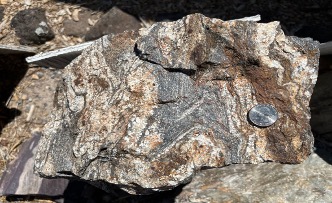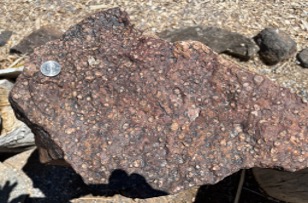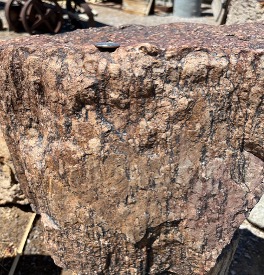By Darrel Cowan
The oldest rock in the region of the proposed Amargosa Basin National Monument is about 1.7 billion years old. We informally call this geologic unit the “basement,” because it sits under the entire region and all the younger sedimentary formations you can see now were deposited above it. It comprises diverse rock types—mostly schist and gneiss—that all show evidence of having been heated and metamorphosed, that is, changed from their original character under heat and pressure over time. The sample in the “Walk through Time” outside of the Shoshone Museum is a gneiss displaying attractive folded layers (see image below).
A gneiss sample on display outside of the Shoshone Museum.
Another rock unit present throughout the area is the pink Zabriskie Quartzite, made up of small, millimeter-sized grains of the mineral quartz. Quartz-rich sands in the Amargosa were deposited near the shore of the ocean about 535 million years ago.
Zabriskie Quartzite also contains an interesting trace fossil, evidence of early life, called Skolithos. In a sample also displayed outside of the Shoshone Museum, the fossil appears as vertical tubes filled with sand, but when viewed looking down at the top of the specimen, one can easily see the circular tubes in cross section. We don’t know the exact identity of the animal that made the tubes, but it might have been a worm-like creature that consumed and passed beach sand.
Come check out the fascinating geology of the Amargosa Basin on exhibit and out in the field, and learn more about what makes this unique area so special!
Zabriskie Quartzite from above, revealing fossilized vertical tubes deposited by early life.
Zabriskie Quartzite from a side angle, showcasing the result of heat and pressure applied over time.



